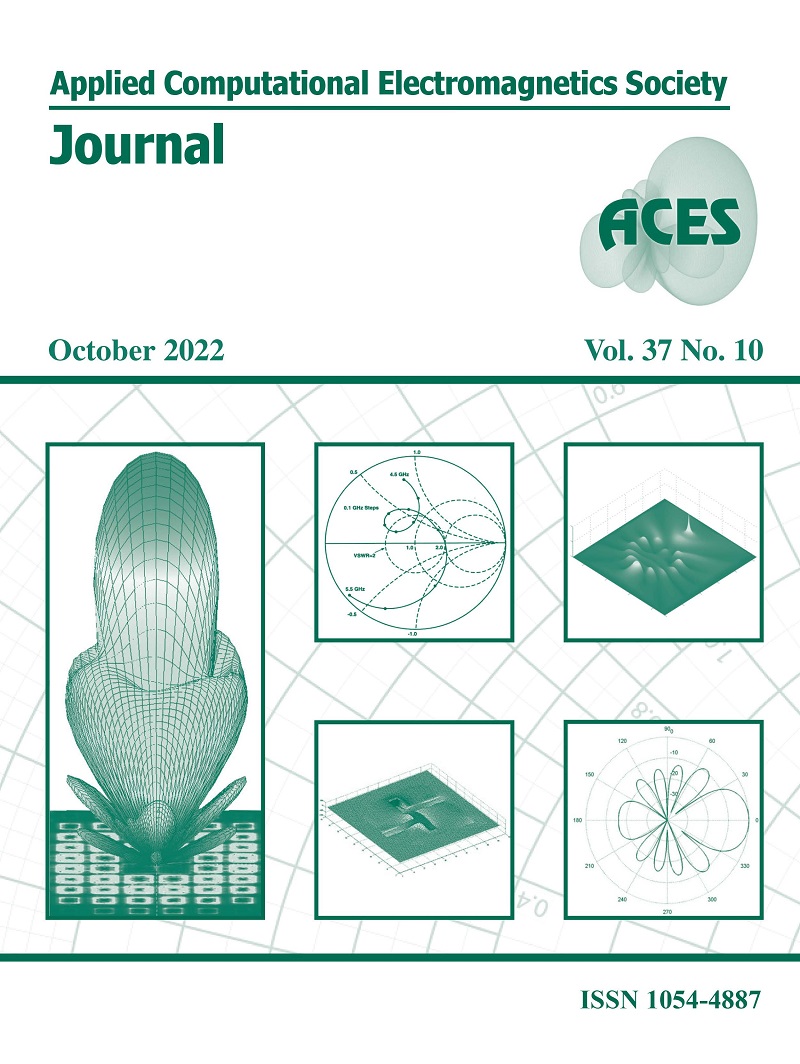Localization of Breast Tumor Using Four Elements UWB Wearable Antenna
DOI:
https://doi.org/10.13052/2022.ACES.J.371002Keywords:
cavity, heterogeneous phantom, Specific Absorption Rate (SAR), wearable UWB antennaAbstract
In this paper, four wearable UWB antennas are designed to detect and locate tumor cells placed within a heterogeneous phantom at different positions. The proposed antenna is operated within the 4.90 GHz to 15.97 GHz bandwidth range. It is fabricated, measured, and nearly matched between measured and simulated results. A cavity is formulated to back each antenna within the proposed detection system for increasing penetration and gain of propagated electromagnetic waves of the antenna design. The S-parameter of the proposed system was used to detect and locate a small tumor. The SAR results show that the absorbed power by the breast phantom tissues satisfies the IEEE standards which confirms the appropriateness of the proposed antennas for breast cancer early detection and localization system.
Downloads
References
WHO | World Health Organization.
U.S. Breast Cancer Statistics.
S. A. Narod, “Tumour size predicts long-term survival among women with lymph node-positive breast cancer,” vol. 19, pp. 249-253, 2012.
A. B. Miller, C. Wall, C. J. Baines, P. Sun, T. To, and S. A. Narod, “Twenty-five-year follow-up for breast cancer incidence and mortality of the Canadian National Breast Screening Study: randomized screening trial,” Obstetrical & Gynecological Survey, vol. 69, pp. 329-330, 2014.
H. M. El Misilmani, T. Naous, S. K. Al-Khatib, K. Y. Kabalan, “A survey on antenna designs for breast cancer detection using microwave imaging,” IEEE Access, vol. 8, pp. 102570-102594, 2020.
H. Bahrami, E. Porter, A. Santorelli, B. Gosselin, M Popovic, and L. A. Rusch, “Flexible sixteen monopole antenna array for microwave breast cancer detection,” 36th Annual International Conference of the IEEE Engineering in Medicine and Biology Society, Chicago, IL, pp. 3775-3778, Aug. 2014.
H. Bahrami, E. Porter, A. Santorelli, B. Gosselin, M. Popovic, and L. A. Rusch, “Flexible 16 antenna array for microwave breast cancer detection,” IEEE Transactions on Biomedical Engineering, vol. 62, no. 10, pp. 2516-2525, Oct. 2015.
E. Porter, H. Bahrami, A. Santorelli, B. Gosselin, L. A. Rusch, and M. Popović, “A wearable microwave antenna array for time-domain breast tumor screening,” IEEE Transactions on Medical Imaging, vol. 35, no. 6, pp. 1501-1509, Jun. 2016.
M. Mamun U. Rashid, A. Rahman, L. C. Paul, J. Rafa, B. Podder, and A. K. Sarkar, “Breast cancer detection & tumor localization using four flexible microstrip patch antennas,” International Conference on Computer, Communication, Chemical, Materials, and Electronic Engineering (IC4ME2), Rajshahi, Bangladesh, Jul. 2019.
F. Alsharif and C. Kurnaz, “Wearable microstrip patch ultra-wide band antenna for breast cancer detection,” 41st International Conference on Telecommunications and Signal Processing (TSP), Athens, Greece, Jul. 2018.
A. Afyf, L. Bellarbi, A. Achour, N. Yaakoubi, A. Errachid, and M. A. Sennouni, “UWB thin film flexible antenna for microwave thermography for breast cancer,” International Conference on Electrical and Information Technologies (ICEIT), Tangiers, Morocco, May 2016.
A. Afyf, A. Elouerghi, M. Afyf, M. A. Sennouni, and L. Bellarbi, “Flexible wearable antenna for body centric wireless communication in S-band,” International Conference on Electrical and Information Technologies (ICEIT), Rabat, Morocco, Mar. 2020.
T. Abouelnaga and E. A. Abdallah, “Ultra-compact UWB power divider for 5G Sub-6 GHz wireless communication system,” International Journal on Communications Antenna and Propagation (IRECAP), vol. 12, no. 2, pp. 90-97, 2022.
S. J. Chen, B. Chivers, R. Shepherd, and C. Fumeaux, “Bending impact on a flexible ultra-wideband conductive polymer antenna,” International Conference on Electromagnetics in Advanced Applications (ICEAA), Turin, Italy, Sep. 2015.
A. I. Hammoodi, H. Al-Rizzo, A. A. Isaac, A. S. Kashkool, K. Gamer, and H. Khaleel, “Studying the effect of bending on the performance of flexible dual-band microstrip monopole antenna,” IEEE Conference on Antenna Measurements & Applications (CAMA), Syracuse, NY, Oct.2016.
D. Awan, S. Bashir, and W. Whittow, “High gain cavity backed UWB antenna with and without band notch feature,” Loughborough Antennas & Propagation Conference (LAPC), Loughborough, UK, Nov. 2013.
M. Abdel-Haleem, T. Abouelnaga, M. Abo-Zahhad, and S. Ahmed, “Enhancing microwave breast cancer hyperthermia therapy efficiency utilizing fat grafting with horn antenna,” International Journal of RF and Microwave Computer-Aided Engineering, vol. 31, no. 6, pp. 1-13, 2021.
P. T. Nguyen, A. M. Abbosh, and S. Crozier, “Thermo-dielectric breast phantom for experimental studies of microwave hyperthermia,” IEEE Antennas and Wireless Propagation Letters, vol. 15, pp. 476-479, 2015.
T. M. Fiedler, M. E. Ladd, and A. K. Bitz, SAR Simulations & Safety, NeuroImage, vol. 168, pp. 33-58, 2018.
V. Sathiaseelan, “Application of numerical modeling techniques in electromagnetic hyperthermia,” Applied Computational Electromagnetics Society (ACES) Journal, vol. 7, no. 2, pp. 61-71, 2022.
T. Abouelnaga, I. Zewail, and M. Shokair, “Design of 10 ×
massive MIMO array in sub-6 GHz smart phone for 5G applications,” Progress in Electromagnetics Research B, vol. 91, pp. 97-114, 2021.




